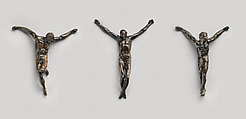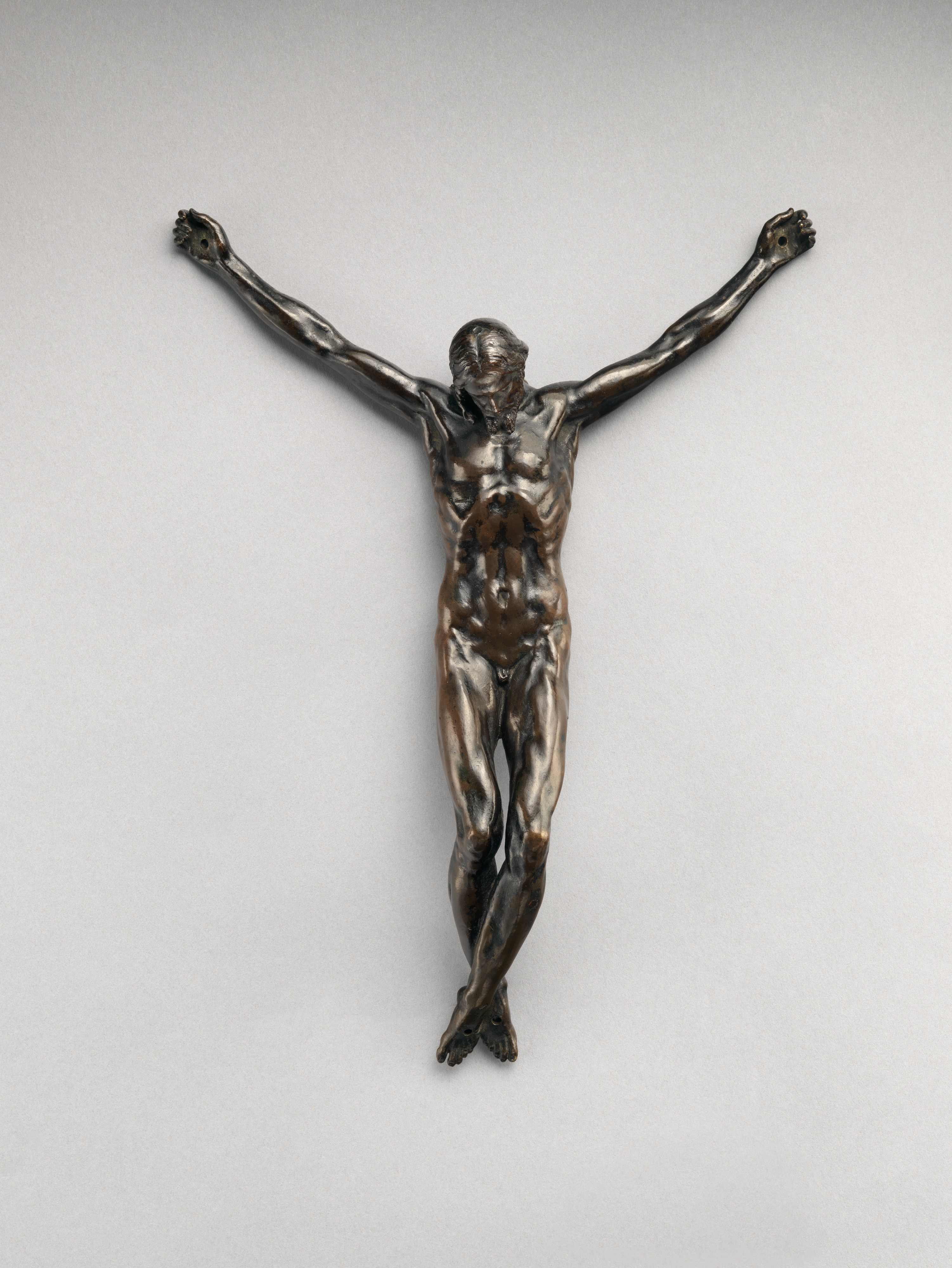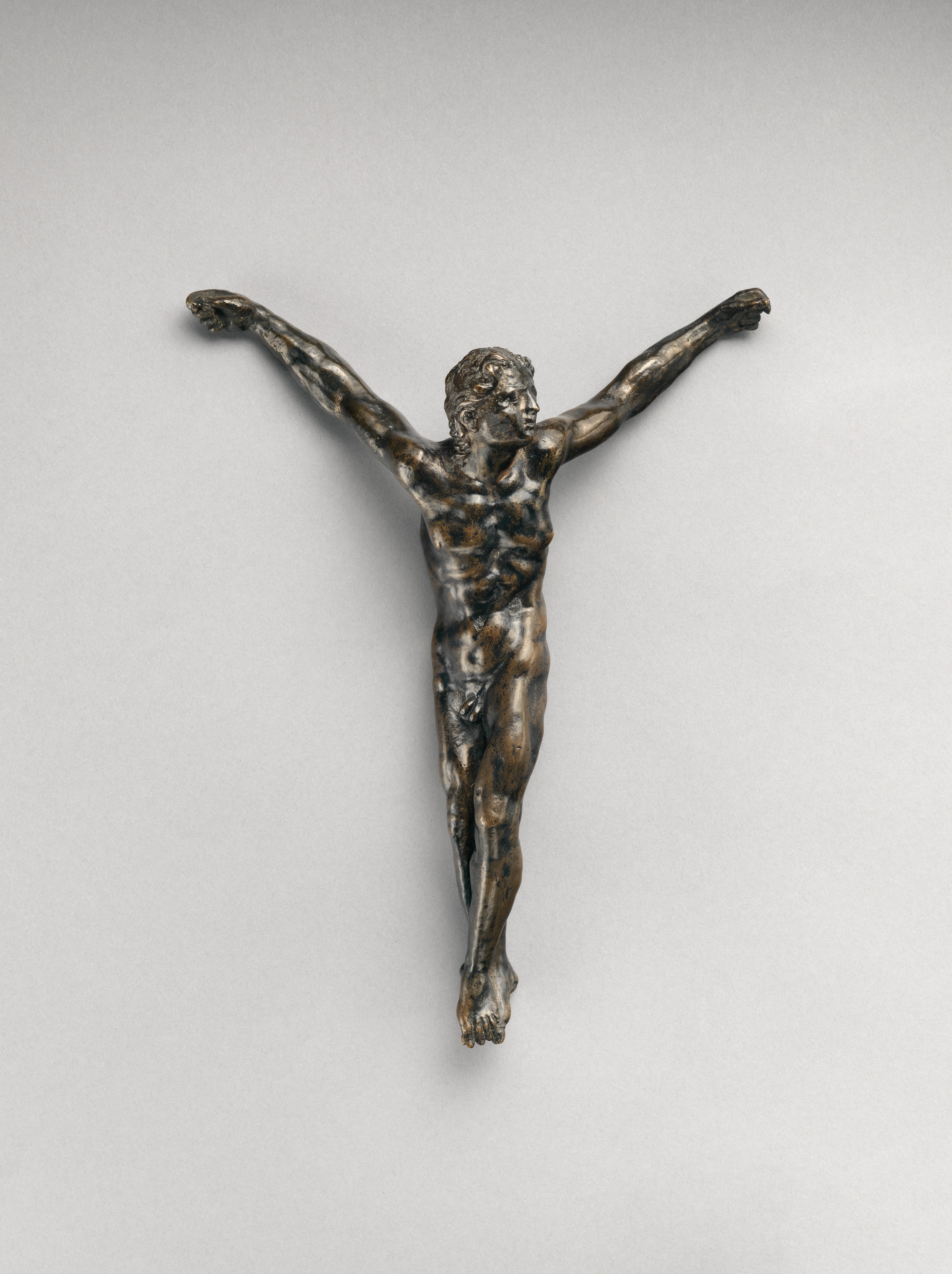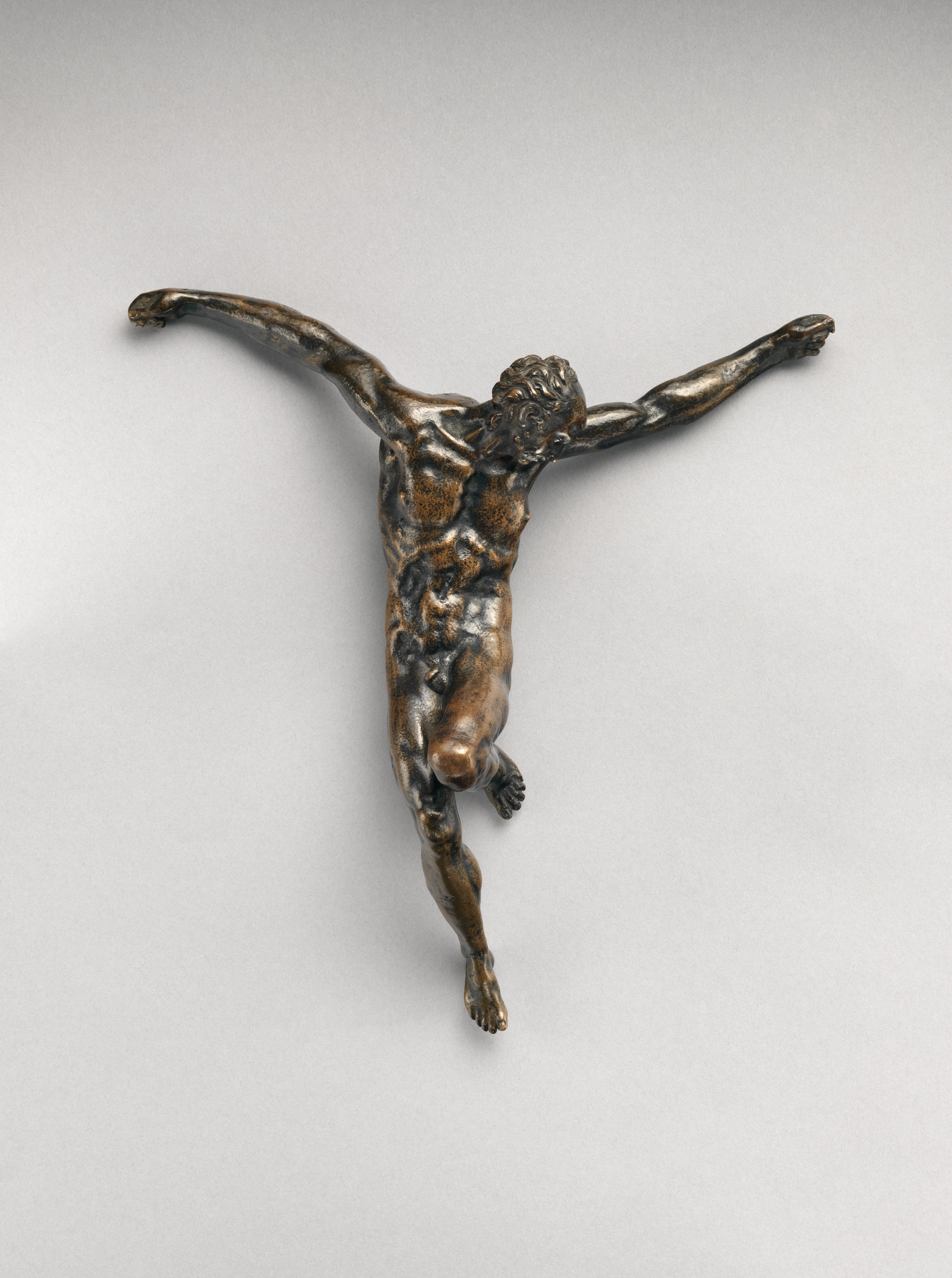Christ and the Two Thieves Crucified
The bronzes are unrecorded before 1899, by which time they were already mounted on modern metal crosses and stuck into a deplorable Golgotha base resting on couchant lions (fig. 101a).[1] Met curators Preston Remington and John Goldsmith Phillips had not planned to exhibit the figures on that base, but it was in fact reused in installations into the 1970s. Those curators’ eyes had been sensitized to late Michelangelo: in the 1930s, the museum seriously contemplated acquiring first the Palestrina Pietà, the marble now in the Galleria dell’Accademia, Florence, no longer generally accepted as Michelangelo, and then his haunting Rondanini Pietà, the marble now in the Castello Sforzesco, Milan, but was stymied in both cases. Most writers have sensed Michelangelo’s authority behind our bronzes despite their small size. Zaccaria Zacchi, a Tuscan hack proposed by Anderson Galleries in 1921, was a dead end.
According to Scripture (Luke 23:33–431), Christ was crucified between two robbers. The wickeder of the two cursed Jesus, but the other proclaimed Jesus’s innocence and asked for his blessing. The latter thief, the “Good Thief,” later known as Dysmas, is always positioned to Christ’s right as a mark of favor. He is traditionally younger and beardless, his countenance directed toward Jesus. His counterpart, the impenitent “Bad Thief,” later styled Gesmas, is bearded, older, uglier, and often turns away from Christ, his body writhing. Christ is normally the tallest figure when just he and the thieves are shown together; an early occurrence is the celebrated wood panel on the doors of Santa Sabina, Rome, from about 430–35.[2] Popular imagery only rarely presents the three without witnesses, particularly as the scene expanded to include many participants, chief among them the Virgin Mary and Saint John.[3] Some reenactments in painting, memorably the Calvary of Duccio’s Maestà (Museo del Duomo, Siena) and Antonello da Messina’s panel of 1475 (Koninklijk Museum voor Schone Kunsten, Antwerp), distinguish the three crucified ones by raising them on tall crosses and silhouetting them against the sky above the rest of the company. Excerpting them from the busier narration, as here, seems to have been exceptional in sculpture and to have stemmed largely from Michelangelo’s preoccupation with the subject of the Crucifixion in his last years. One painter who may have benefitted was Peter Paul Rubens, whose Three Crosses (Museum Boijmans Van Beuningen, Rotterdam) is just that: the three figures alone, dramatically lit. Otherwise, it is untouched by the Michelangelesque statuettes, but the powerful arms and bulging proper left thigh of Dysmas may perhaps be sensed in Rubens’s great Crucifixion painted for Antwerp in 1620 (now Musée des Augustins, Toulouse).[4]
The present trio differ from each other in physiological typology, style, and modeling. Christ is looser-limbed, relatively more svelte, and marginally taller than the thieves, and is more thinly and evenly cast.[5] Totally nude, head sunk onto chest, his type is that of a Cristo morto. As seen in X-radiographs, for the Christ and the Bad Thief, the two halves of wax intermodels were joined at the waist; for the Good Thief, the joins are located between the arms and shoulders. All three bronzes contain extremely fine iron-wire core pins, only about half a millimeter in diameter and locatable by magnet on the surface, where they have left rusty specks. The Bad Thief stands out from the others because of the allover stippling, apparently carried out with a small punch. The tin bronze alloy is the same in all three, as are the remains of dark paint. There is not enough rubbing on any figure to suggest a mode of attachment or display. None of the technical data helps determine the sequence of events that led to their assembly as a group or their original placement in relation to each other. Christ’s arms stretch upward, his palms and feet pierced for suspension by nails. His body constitutes a crux immissa on a horizontal beam, as opposed to either of his companions’ crux commissa, an upright cross to which each was bound rather than nailed. The thieves are portrayed as still alive, the one submissive, imploring; the other kicking angrily at his fate.
The pure, resigned character of the Christ recalls Michelangelo’s early years, beginning with the wood corpus in Santo Spirito, Florence, and the dead Christ in his painted Entombment (National Gallery of Art, London).[6] Their heads, tranquilly symmetrical, have descended little changed in the bronze. In his old age, Michelangelo was more than ever obsessed with the challenge of conveying the divine love expressed by the crucified. A sonnet of 1554 says it all: “There’s no painting or sculpture now that quiets/The soul that’s pointed toward that holy Love/That on the cross opened Its arms to take us.”[7] Equally Christocentric is a drawing of the nude Savior, armless and shown in cross section, in the Palais des Beaux-Arts de Lille.[8] In it, Michelangelo cogitates the same figure as our bronze, around which is shaped a study for a church portal. The musculature was elaborated in a famous drawing in the Teylers Museum, Haarlem, which includes a profile cross section without a left arm.[9] Among Michelangelo’s more elaborate drawings of the dead Christ, one in the Royal Collection, Windsor, comes closest to our model.[10] The arms are at the same angle, and shading suggests momentary hesitation in moving the slightly sideward hips to a more frontal presentation. Michelangelo captured the same brilliant modeling of the statuette’s taut abdominal cavity in a Pietà now in the Ashmolean.[11]
The form of the corpus was literally transcribed in about the same scale, with an added perizonium, in the Golgotha relief installed on the large, complex tabernacle now in the Certosa di San Lorenzo at Padula, contracted from the Sicilian-born disciple of Michelangelo, Jacopo del Duca (fig. 101b).[12] He was at work with the master on the Porta Pia by 1562. The Padula tabernacle was ordered by Pius IV for the Roman church of Santa Maria degli Angeli. Jacopo clearly had free access to the aged master’s models and drawings for the tabernacle, which originally boasted lapis lazuli columns. Owing to expense, work on its bronzes stopped in 1565, to be resumed after 1568 with help from the little-known painter Jacopo Rocchetti.[13] All eight of its reliefs have impoverished modeling as well as casting flaws, at variance with the technical mastery asserted by the cast elements of the tomb of Elena Savelli in San Giovanni in Laterano, Rome, commissioned in 1570, in which Jacopo del Duca’s role was that of architect, while his brother Ludovico, a known talent in bronze sculpture, modeled and cast the superlative bust and fittings.
The type of the corpus circulated chiefly in Spain in both bronze and silver, and whether ours was made in Rome or Spain is open to question.[14] Its context is Roman, but the quality of modeling and casting, both crisp and fluid, brings it closer to numerous surviving silver copies in Spain. Each is about 22 cm in height and equipped with a perizonium, except for an entirely nude example that was in the collection of Manuel Gómez Moreno in 1930.[15] Francisco Pacheco was the first to write about these copies in Arte de la pintura, published posthumously in 1649. According to Pacheco, it was an Italian goldsmith working in Seville, whom he called Juan Bautista Franconio, who brought a 30 cm bronze after Michelangelo’s model from Rome in 1597. Pacheco polychromed the first of the casts in 1600 and gave it to Pablo de Céspedes, a prebendary of the Cathedral of Córdoba, who wore it around his neck.[16] What interested Pacheco most was that the Michelangelo-Franconio corpus perpetuated a vision of Saint Bridget of Sweden, in which Jesus was nailed to the cross by four nails, his left ankle wrapped over his right, and that this devotional formation in turn influenced the great Sevillian sculptor Juan Martínez Montañès.[17] Quite a few bronze corpora without attendant thieves survive, exhibiting varying degrees of Michelangelesque influence, quality, and finish.[18]
In his rebellious attitude, our Gesmas, the Bad Thief, exhibits reasonably well-researched anatomy. His right arm is impossibly curved, though clearly in the interest of expression. He is balding, and the stippling gives him a more exciting surface than those of his companions. His twisted torso goes back to a quick sketch by Michelangelo in the Casa Buonarroti, Florence.[19] In it, the arms are severed, raising the question of whether the master was already working from a wax or clay model. An unknown Michelangelo follower retained the pose of the two thieves while changing Christ’s altogether in a drawing now in the Louvre.[20] Gesmas looks less wicked when youthful and beardless, as in an anonymous sixteenth-century drawing in the Teylers Museum (fig. 101c).[21] The three-dimensional model, which we presume was by the master, was surely broken by this time, to judge by the severed arms. It circulated widely, probably in the form of armless plasters.[22] Unimpressive torsos exist in bronze, in the Louvre, the Bode-Museum, the Museo Poldi Pezzoli, Milan, and elsewhere. Altogether lacking in detail, they increasingly have been relegated, rightly, to the nineteenth century.[23]
One wonders whether late casts of Gesmas were authorized by the dealer Stefano Bardini when he owned our group. A poor cast is still in the Museo Bardini, Florence. Cataloguer Tommaso Rago errs in saying it is the same as ours, not realizing that the whole ex-Bardini group of three came to The Met together.[24] A chief difference is that the Museo Bardini figure retains cast-in ropes at the wrists and ankles.
There is no source in Michelangelo for our Dysmas. Instead, the weak modeling gives an impression of wax being pinched like dough. The small head, heavily lidded eyes, stringy hair, inarticulate ribcage and limbs, and slovenly casting are met throughout the reliefs by Jacopo del Duca at Padula. Casts of this figure are not encountered apart from groups.
Plangent echoes of both thieves of our types, flanking a completely different Christ, are in the Castello Sforzesco, Milan (fig. 101d). The Milan Christ, more than a foot in height (32 cm), again dominates, but the whole ensemble has more coherence and presence. This Savior is more massive, head slumped to the side, and wears a form-fitting perizonium, a type of “wet” drapery. His right foot now overlaps his left, both nailed through. The model of the Good Thief in Milan is now much clarified with a readable thorax and a yearning expression. Both thieves have integrally cast ropes.[25]
The Milan group was exhibited with ours in Montreal in 1992, and both were well discussed in the 2011 Castello Sforzesco catalogue. Milan probably provided the entire context for the Castello Sforzesco bronzes. They are first recorded in the collection of the Milanese painter Giuseppe Bossi (d. 1815), who bequeathed them to the city’s Museo Patrio Archeologico.[26] It is highly likely that the casts as well as the compositions originated in Milan. A name to consider is Francesco Brambilla, or perhaps his immediate circle. Recent scholarship has increasingly clarified Brambilla’s oeuvre. If he did not cast small bronzes himself, he is the documented modeler of bronzes both large and small, all displaying much the same high center of gravity, the massive but clinging “wet” drapery of the Castello Sforzesco Christ, and the melodiously undulating hair. The Risen Christ on the tabernacle of the high altar in Milan Cathedral, cast according to Brambilla’s model in 1588, displays these traits.[27] They are even more pronounced in angels for the same altar, cast in 1598 by Giovanni Battista Busca based “on the model presented by Brambilla,” and in apparently posthumous statuettes of angels with instruments of the Passion on the tabernacle of the high altar of the Certosa di Pavia, cast by Annibale Busca in 1603–5.[28] In all these works, as in the Castello Sforzesco Christ, the same delicacy of modeling and excellence of casting are in balance with Milanese Counter-Reformation corporeality and sobriety. The two thieves in Milan, while far less original, are to all appearances cast by the same founder as the Christ.
Volker Krahn published a previously unknown bronze group in the Hildesheim Cathedral Museum, in which thieves of the Milan type and close to the same size flank an altogether new, classically Baroque Christ, rising above the Virgin, the Magdalen, and Saint John, all on a modern Golgotha base reconstructed from an old photograph.[29] Krahn catalogues the ensemble as South German, second quarter of the seventeenth century. The main point of interest is that the figures are graduated in size, with the Virgin and Saint John the largest, the Magdalen and Christ smaller, and the thieves smaller still—raising the possibility that such groups received theatrical perspectival stagings.
The London firm of Tomasso Brothers in 2006–9 had thieves of the Milan types, but of indeterminate facture, with the Bad Thief showing a more heroic mien and fuller hair.[30] In 2006, Christie’s London had a set of three in stucco (not terracotta, as advertised).[31] They are close in size to each other, but the thieves follow the Milan models, while the Christ has an agonized sideward torsion and a fully fle[dged Baroque mien.
-JDD
Footnotes
(For key to shortened references see bibliography in Allen, Italian Renaissance and Baroque Bronzes in The Metropolitan Museum of Art. NY: The Metropolitan Museum of Art, 2022.)
1. A photograph showing them in a case in the Galleria Bardini is dated about 1902 in Chini 2009, p. 200, fig. 99, but could date earlier or later.
2. Merback 1999, p. 79, fig. 25.
3. For an exception, see the German woodcut in ibid., p. 26, fig. 4.
4. Judson 2000, pp. 139–46, no. 37, fig. 118.
5. R. Stone/TR, October 21, 2010.
6. For the wood corpus, see Florence 1999, pp. 288–90. The subtle ideality of its slim body, without the sideward turn, also continues to inform the bronze. For the Entombment, see Hirst 1994, pp. 56–81.
7. Michelangelo 1963, p. 159, no. 283.
8. Not, as Tolnay and others would have it, an idea for the Rondanini Pietà (Tolnay 1975–80, vol. 3, p. 94, no. 595v. 7). The drawing, like the statuette, activates the model much more than does the Rondanini Pietà, which is probably Michelangelo’s final word on the dead Christ. 9. Tolnay 1975–80, vol. 2, no. 250r.
10. Ibid., vol. 3, no. 418r.
11. Ibid., no. 433r. A Louvre pen drawing, attributed to Raffaello da Montelupo with a question mark in Joannides 2003, p. 224, no. 78, does not relate to our statuette, as claimed. Its Christ is stockier, his feet are reversed, and the abdominal cavity is treated as a diamond, not an oval.
12. For Jacopo’s biography, see Benedetti 1988. For the reliefs, formerly in the Capodimonte, see Venturi 1935–37, vol. 2, figs. 145–54; Schiavo 1973; Montagu 1996, pp. 20–30, 199–200; and, for the monument’s vicissitudes, Tagliolini 1997. After the Padula tabernacle, Jacopo’s brother Ludovico del Duca made another for Santa Maria Maggiore, Rome, between 1587 and 1589, using some of the Michelangelesque models but a new composition for the Crucifixion panel (Montagu 1996, p. 29, fig. 40). Between the two, in 1574–78 “Jacomo del Duca” and “Jacomo Rocchetto” had proposed a tabernacle to Philip II, who turned it down (ibid., pp. 199–200).
13. For Rocchetti and his relationship to Michelangelo and Jacopo del Duca, see Sickel 2016; Parlato 2016; Bambach 2017, p. 261.
14. For a partial idea of the Spanish corpora, see Gómez Moreno 1930, pp. 189–93 (painted bronze, ducal house of Benevente; silver examples, Palacio Real, Madrid, and that in Gómez Moreno’s own collection); Gómez Moreno 1933 (an unpainted bronze); Lozoya 1971 (silver examples, Caja de Ahorros, Segovia, Museo del Catedral, Valladolid); Romero Torres 1984; F. Martín 1987, p. 23, no. 3.
15. Gómez Moreno 1930 and 1933.
16. Pacheco 1990, pp. 497–98, 725.
17. Proske 1967, p. 41. Saint Bridget’s Revelationes, published in Rome in 1556, could very well have prompted Michelangelo’s formulation. As Proske quotes the saint, after Jesus was nailed by his arms: “Then they crucified the right foot, and over this the left foot with two nails.” 18. An exhaustive list is impossible. Two were recently on the market: Bonham’s, London, April 15, 2008, lot 18 (nude, gilt); private collection (nude, detachable gilt loincloth), brought to our attention by Giancarlo Fenyo, 2010; electronic dossier prepared by Michael Riddick, 2015.
19. Tolnay 1975–80, vol. 2, no. 251r.
20. Joannides 2003, no. 79 (as possibly by Giulio Clovio).
21. Tolnay 1943–60, vol. 5, p. 173, fig. 332. Inscribed “il ladrone di Micel l’Agnolo Bonaroti,” it is the earliest identification of the model with the master.
22. One was drawn twice in the sixteenth century by Francis Cleyn (now University of Southampton). Howarth 2011, p. 465, fig. 58.
23. See Rovetta 2011, pp. 232–33; Satzinger and Schütze 2015, cats. 223–25.
24. Nesi 2009, pp. 150–52, no. 51.
25. The Bad Thief’s left leg kicking free of his rope reminded Ottolenghi (in Rovetta 2011, p. 238) of Bertoldo’s Crucifixion relief in the Bargello, but there is no formal relationship.
26. Nenci 2004, p. 167.
27. Morandotti 2005, pl. 203.
28. For the Milan angels, see ibid., pl. 205; and Gentilini and Morandotti 1990, p. 154, fig. 26. For the Certosa di Pavia angels, see Susanna Zanuso in Beltrami 2006, pp. 240–41, 270; Zanuso 2008b, p. 289, fig. 21.
29. Brandt 1991, cat. 23.
30. London 2009, pp. 24–27, cat. 8.
31. Christie’s, London, July 6, 2006, lot 144.
Due to rights restrictions, this image cannot be enlarged, viewed at full screen, or downloaded.
This artwork is meant to be viewed from right to left. Scroll left to view more.





